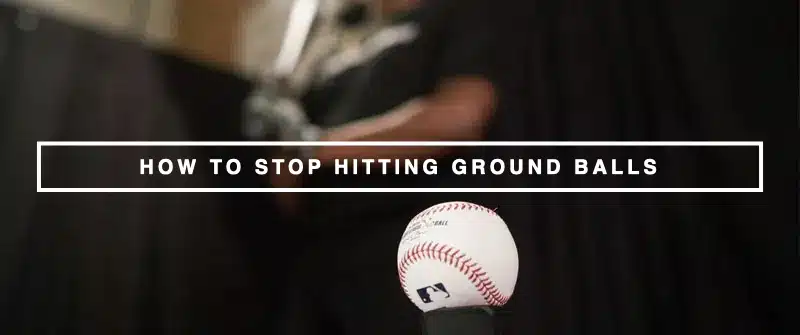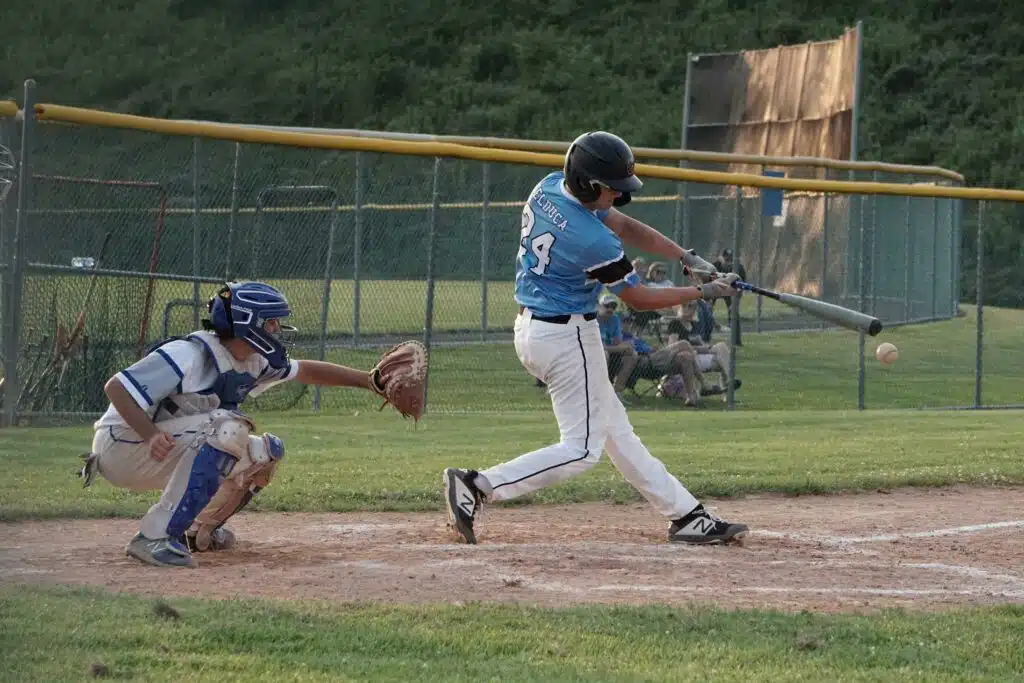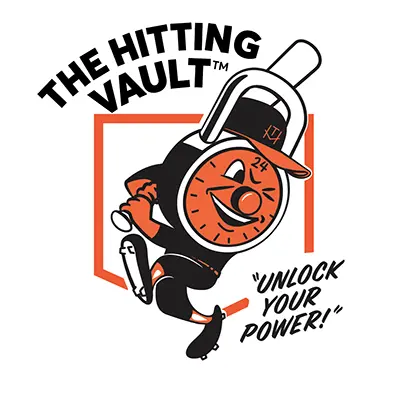Mastering Your Swing: How to Stop Hitting Ground Balls

Table of Contents
You may be asking yourself, “Why do I hit a lot of ground balls?” Or “How can I help my child stop chopping down on the ball?” Constantly rolling over or hitting ground balls can feel like a setback for many players striving to have success at the plate. At the heart of this issue? Swing mechanics. A poor swing path can be the difference between an easy out to the infield and one that clears the fences.
The sooner it gets fixed, the better off you’ll be. As hitters get older, the defense gets faster, with better reaction time, better footwork, and better arm strength. By the time hitters reach high school the amount of infield errors, or ground balls that get through the infield drops dramatically.

Whether it’s adjusting your swing to avoid the downward path that sends the ball straight to an infielder or fine-tuning your approach to increase your launch angle, we’ve got you covered. Let’s dive into the science of swing mechanics and how to stop hitting ground balls.
The Fundamentals of an Elite Swing
Transforming your performance at the plate starts with mastering the basics. A hitter’s stance, grip, and swing path are the foundation of every powerful hitter. Let’s break down these essentials to ensure your swing has the basics to set your swing up for success. For members of The Hitting Vault, we break down these fundamentals into six simple phases that we call our SwingBuild program.
Proper Stance and Grip
It all begins here. Your stance should be comfortable yet powerful, providing a stable base for your swing. To have a stance that is the most simplest form for young hitters to replicate, keep your feet shoulder-width apart, knees slightly bent, and weight evenly distributed. For more information on the common issues we see with hitters and their stance, check out article Top 5 Mistakes Hitters Make in Their Stance.
As for grip, hold the bat with your fingers and where your calyces are, not the palms. This ensures control and flexibility. This setup is crucial for a swing that’s both swift and accurate. Hitters that have it too deep in their hand not only prevent the natural whip that happens, but also could get injured in their thumb if they’re late on a pitch.
Optimal Swing Path
Think of your bat as a plane taking off, not digging through the dirt. An upward swing path, even if it’s just slight, is key to getting under the ball the right amount and launching it into the air for a line drive. This path allows you to make contact with the ball in a way that maximizes force while minimizing the risk of those easy ground balls. Swinging the bat on a path that matches the trajectory of the ball coming in, will make for a good launch angle. Launch angle is the angle of the ball off the bat. It can be a positive angle (up in the air), zero degree angle (straight out), or a negative degree angle (ground ball).
As a guideline, here are the Launch Angles for different types of contact:
- Ground ball: Less than 10 degrees
- Line drive: 10-25 degrees
- Fly ball: 25-50 degrees
- Pop up: Greater than 50 degrees
Point of Contact
Timing and placement matter. The ideal point of contact varies with pitch location. Here’s a simple breakdown for each location:
Inside: in front of your front foot 3-6 inches
Middle: lined up with your front foot to slightly in front
Outside: inside your front foot 3-6 inches
By focusing on these contact points whenever you’re working on a tee, you’ll set yourself up for more consistent, powerful, and elevated ball flight. Remember, small adjustments can lead to big improvements.
Drills to Improve Bat Speed
Unlocking your full hitting potential requires not just good swing path and direction, but speed and precision. Here are targeted drills to rev up your bat speed, and sharpen your visual acuity and timing. Implement these into your training routine to send ground balls packing.
If you’re looking for specific tips and drills on improving you bat speed, check out The Hitting Vault Bat Speed Training Program.
Weighted Ball Swings
Heavier than a regular baseball, weighted balls can be used to make sure you’re increasing speed near contact and are in a solid contact position. If you aren’t doing either of those, the weighted balls will let you know.
Weighted Bat Training
Changing the weight of the bat definitely help with increasing bat speed. We have a great Bat Speed Training program that tells hitters step by step how many swings to take with a light tee ball size bat, how many ounces to increase or decrease their bat weight, and how to actually do that.
Swing Plane Drills
Tee Work with an Elevated Front Tee
All homeruns are hit with backspin, to create backspin you need to hit the bottom half of the ball. Set up two tees about 4 inches apart, with the front tee slightly higher (about an inch). This encourages a slightly upward swing path, teaching you to hit the bottom half of the ball.
PVC Pipe Drill
Sometimes taking out the bat from a hitter’s hands is the key to helping them move more efficiently. A PVC pipe can be used in a number of different ways. We have an entire PVC warmup routine for Vault members that helps them in each phase of the swing, especially with having a good first move to the ball that is on plane.
Visual and Timing Drills
Soft Toss Variation
Have a partner toss balls from different angles and speeds. This forces you to adjust your timing and swing to make solid contact.
The Tennis Ball Drill
Write numbers or colors on tennis balls. As they’re tossed to you, call out what you see before making contact. This drill enhances your ability to see the ball sooner and react quickly. You can also progress to only hitting “even” numbers and watching the “odd” numbers go by.
Incorporating these drills into your practice sessions will not only boost your bat speed and control but also improve your ability to connect with the ball more effectively. Consistent practice leads to noticeable improvements, turning those ground balls into line drives and fly balls.
Advanced Techniques for Hitting for Power
To transcend from hitting ground balls to becoming a power hitter, understanding and mastering advanced techniques is key. This section explores how to effectively load and explode, leverage your lower body, and adjust to different pitches for maximum power and the right amount of elevation.
Loading and Exploding
Loading: Think of loading as the coiling spring action before the leap. It’s about gathering your energy before the swing. Most elite hitters achieve this by slightly coiling into their back hip and creating hip hinge. The front shoulder should work slightly down and in as well. The load should be slow and controlled. If it’s rushed or if there’s no loading, then this will negatively affect the hitter’s timing and ability to adjust.
Exploding: This is the release of the energy you’ve gathered. Starting with your legs and hips, uncoil the energy, transferring it through your core, into your arms, and finally to the bat. This explosive action is what gives your swing its power. The key is seamless energy transfer and timing. If your body is sequencing well, your swing will feel more effortless. If you feel like you’re trying really hard to still not hit the ball well, there’s something mechanical going on that will prevent you from improving.
Leveraging the Lower Body
Your legs and hips are the powerhouse of your swing. To tap into this power:
Use your legs: Initiate your swing with a stride forward that is comfortable for you. For some that’s a longer stride. For others, starting wider and having a small stride, or a simple heel up and heel down. Regardless, you should be in your legs at launch position (aka heel plant). Being in your legs will prime you for the explosive phase.
Rotate your hips: As you begin to swing, rotate your hips explosively. This rotation is crucial for transferring power from your lower body through to your upper body and into the bat.
Adjusting to Different Pitches
To maintain power against various pitches, flexibility in your approach is crucial:
High Pitches: For pitches that are higher in the strike zone, focus on meeting the ball with a slightly more level swing to ensure you’re driving the ball with force.
Low Pitches: When dealing with low pitches, you will need to side bend more on your first move after launch position in order to get on plane early and still hit the bottom half of the ball. Low pitches are very common for hitters to hit ground balls on. As stated previously, if you hit the top of the ball, it will be a ground ball.
Off-Speed Pitches: First recognizing that a slow pitch is coming is important. You can’t adjust if you never notice that the speed has changed. Once you have recognized the change in speed, maintain some bend in your front knee, and fight to delay your hands from moving forward, this delay is what allows the ball “time to travel.” Off speed pitches tend to tail downward as well, so trying to hit even more of the bottom half of the ball will put you in the right contact point on a pitch that’s breaking down.
Practice Routines and Mindset
Achieving mastery in hitting and eliminating ground balls from your repertoire requires not just physical practice but also a disciplined mindset and an adaptable approach at the plate. Let’s explore how to build a practice routine that fosters skill improvement and a mental framework conducive to growth and resilience.
Routine Development
To translate the techniques and drills discussed into tangible improvements, consistency in practice is key.
Here’s a sample routine to get started:
Daily Warm-Up: Begin with stretching and light cardio to get your blood flowing. Include dynamic stretches focusing on the legs, arms, and torso.
Number of Reps: This is really dependent on the age of the hitter. For young hitters 30-50 swings one or twice a week may be all they have attention for. For middle schoolers, 50-80 3-5 times a week is typically good. High schoolers and beyond 80-150 3-7 days. As a hitter ages, the number of days and swings they put in should correlate to their ultimate career goals. If they’re just wanting to play through high school then 3 times a week is often good. If they’re in travel ball and are wanting to play college/pro, working towards hitting 5-7 days a week should be what they’re hitting.
Bat Speed and Swing Plane Drills: Allocate specific days to focus on each aspect. Start with bat speed drills on Mondays and Thursdays, swing plane adjustments on Tuesdays and Fridays, for instance.
Visual and Timing Practice: Incorporate visual and timing drills into every practice session, as these skills are crucial for recognizing and reacting to pitches. The quicker you can recognize speed, spin, and location, the quicker you can adjust and hit the ball square (technically though, the bottom half).
Live Pitching or Machine Work: At least twice a week, face live pitching or a pitching machine to apply what you’ve practiced in a more game-like scenario.
Video: Have someone take video of your swing from your chest side. This will allow you to see your bat path. If you have a downward bat path and you’re chopping down on the ball, you will hit more ground balls. Sometimes seeing it in slow motion will help you see what your doing, and be able to make adjustments. After working on it for a couple weeks, take more video and see if you can see improvement on your swing path.
Mental Approach
The mental aspect of hitting is as critical as the physical. Embrace the following principles:
Confidence: Believe in your ability to hit any pitch. Confidence comes from preparation and practice, so trust the work you’ve put in.
Patience: Understand that not every at-bat will be perfect. Learn to wait for the right pitch and maintain your composure, even after a strike.
Visualization: Regularly visualize successful at-bats, seeing yourself hitting line drives. This mental rehearsal can enhance your performance in real situations. Almost all elite hitters do visualization. Seems silly, but there’s been a lot of research to prove it’s beneficial.
Frequently Asked Questions
How do you hit fewer ground balls?
Hitting the top of the ball makes the ball go downward. Simply put, hitting the bottom half of the ball, will create good backspin and trajectory on the ball to help it be a line drive to the outfield.
Why is my son (or daughter) only hitting ground balls?
More often than not it’s not a mental hurdle they need to overcome, but rather a mechanical flaw that needs work. Working on drills that will help them get on plane sooner with the pitch and having a positive Attack Angle will help the hitter have a positive Launch Angle in the ideal range.
What is Attack Angle?
Attack Angle is the angle of the bat’s path, at impact, relative to horizontal. A positive value indicates swinging up, and a negative value indicates swinging down, where zero is perfectly level.
What is Launch Angle?
It’s the vertical angle at which the ball leaves a player’s bat after being struck. A launch angle that’s less than 10 degrees means the ball is going downward for a ground ball. A launch angle of 10-25 degrees is a line drive. A flyball is 25-50. And a Pop up is greater than 50. Some hitters can get away with having a higher launch angle than what’s in the typical range because they hit the ball so hard, but for younger hitters and amateurs, shooting for the 10-25 degree range is good.
How do I get my child to stop chopping his baseball swing?
Like we said, this is a mechanical issue causing them to have a negative attack angle. But oftentimes young hitters can’t feel what they’re doing. Taking slow motion video of them in a live game or front toss from their chest side, will be helpful for them to see their swing path. Once they see it, they can then work on drills that will help them work the right way to the ball.
Stop Hitting Ground Balls and Unlock Your Power With The Hitting Vault
In mastering the art of hitting and learning how to stop hitting ground balls, both the journey and the destination are filled with constant learning, practice, and adjustments. By understanding the fundamentals, engaging in targeted drills, and adopting a growth mindset, you’re setting yourself up for success at the plate. If you’re ready to take your hitting to the next level, join The Hitting Vault today.
Unlock access to over 230+ proven hitting drills, comprehensive training videos, and a community of experts and enthusiasts dedicated to improving your game. Don’t let ground balls hold you back—unlock your true potential and start driving the ball with power and confidence.



